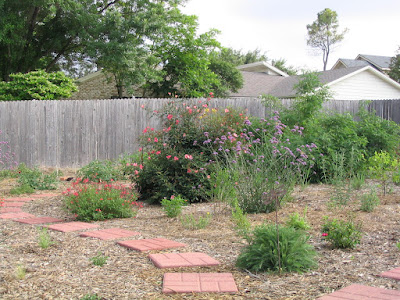I purchased this home in May of 2004. Since I brought over 30 plants from my prior home and I rarely walk away from a plant sale or nursery empty-handed, I immediately began working on the landscaping. Almost five years later, I continue to find the need for a new bed, a bigger bed, a new plant or a plant that needs to be relocated. Below is quick tour of the last four and a half years in my garden.
May 2004. Wasting no time, I removed the planter boxes and scale-covered euonymous that spanned the front of the house. The soil was deep in the planter boxes and fostered past termite infestations.
July 2005. I removed the grass near the house and created large beds for native and adapted shrubs and flowers. In the photo are dwarf yaupon, datura, red yucca, rudbeckia lantana, and coreopsis, Mexican bird of paradise and verbena bonariensis.
July 2005. With the front yard off and growing, it was time to focus on the backyard. After a year of mowing the backyard, I decided I would prefer a natural looking backyard and I began removing all the turfgrass and weeds. It took a summer of weekends to remove the grass by hand. By the Fall, I began planting.
March 2006. This was the start of a very dry year. There was very little rain, lake levels dropped, and the city imposed watering restrictions. Fortunately, I am a native Texan and these conditions are not new to me.
I planted native and adapted plants, used organic gardening techniques, mulched, and watered within the restrictions to establish the plants.May 2006. Even with the drought conditions and limited watering, the plants grew and bloomed.
September 2006. While my neighbors complained that their yards were dead or dying due to the drought and watering restrictions, mine was thriving and full color.
November 2006. A morning dew covers the garden. Clockwise are Mutabilis rose, Deer Grass, Autumn Sage, Lantana, and Mexican Bird of Paradise.
Late February 2007. A dust storm blows in.
June 2007. 2007 was one of the wettest years on record. Many plants had lush growth, however others that prefer drier conditions did not perform as well. Featured in this photo are Liatris, Salvia coccina, Katy Road Pink rose, Artimisia 'Powis Castle', and Clammy Weed.
June 2006.
July 2007. The colorful front flowerbed attracts hummingbirds and butterflies.
July 2007. Rudbeckia 'Goldstrum'
September 2007. Clammy Weed with a honey bee.
September 2007. The beginning of my prairie grass obsession. The Buffalo Grass I planted from seed a month earlier is growing quickly. Indian Grass and Shenandoah Switch Grass are behind the Buffalo Grass.
October 2007. For most of the year, Gulf Muhly does not look too special, but it really shines when the plumes are backlit in the Fall.
October 2007. Shenandoah Switch Grass.
October 2007.
November 2007. Shenandoah Switch Grass glowing in the Autumn sun.
December 2007. "Frost Flowers" on Salvia Coccina. This occurs when moisture in the cell walls of the plant freezes and expands through the stems. The same effect occurs on frost weed.
January 2008
March 2008. Four Nerve Daisy. This is a great flower for well drained, sunny areas. So far, it has bloomed all year for me. Unfortunately, bees and butterflies do not seem very interested in the flowers.
April 2008. Mutabilis rose, Indian Grass, and Buffalo Grass. The Buffalo Grass was planted from seed in August 2007 and was over 12 inches high by April 2008. I was not expecting it to get quite so tall.
Late August 2008 Backyard.
Late August 2008 Backyard.
September 2008 Backyard. Pine Muhly and Indian Grass in the foreground. Flowering Senna is almost finished blooming in the background.
September 2008. Beebrush and Turks Cap.
November 2008. Monarch on Eryngium Leavenworthii.
December 2008. Little Bluestem waiting to be planted. I bought about 60 one gallon plants on clearance for $1.25 each. These will form the foundation for my front yard prairie.

































Great transformation! You've planted such similar things that we plant in Austin - I thought there might be some perennials that do well in Dallas that don't do well here, but it appears that we are similar. As I've mentioned, I grew up in the DFW area, and lived in Addison briefly. I know how picky some Dallasites can be about a manicured lawn; do they turn up their nose at your loosely structured and beautiful natives? Perhaps you can be a model home to show others how great it can look year round. Good work!
ReplyDeleteHi Robin. Thanks for the comments. Until the end of last year, most of my more natural landscaping was hidden in the backyard. That was until I got the idea of doing the same in the front. Now it is out there for all to see. I will post some front yard photos soon.
ReplyDeleteThere is a waterwise garden tour this summer and, if I get some projects finished in time, I am considering adding my garden to the tour.
It is interesting that many of the native plants sold here are actually native to the hill country. Or maybe those are just the ones I grow because I have sunny areas.
I will check out your blog. Thanks for dropping by.
I am so inspired by your work!!! May I ask: what method of watering did you do in the beginning to establish the plants?
ReplyDeleteJust came across this and found it very inspiring. I love the transformation and progress photos.
ReplyDeleteThanks. I am posting updates on Instagram now.
Delete